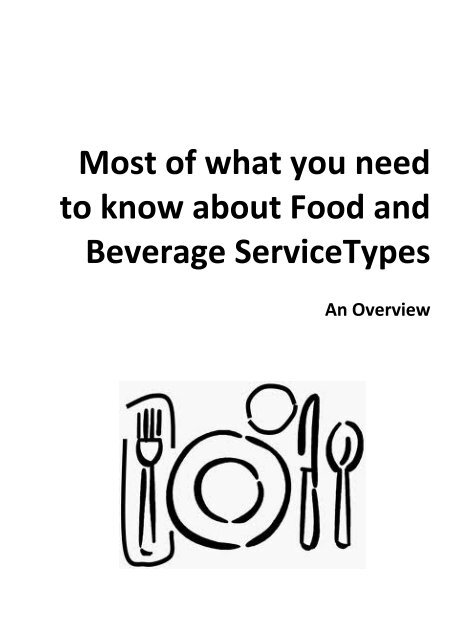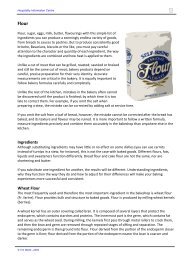The Food & Beverage Service Industry - Info Centre
The Food & Beverage Service Industry - Info Centre
The Food & Beverage Service Industry - Info Centre
You also want an ePaper? Increase the reach of your titles
YUMPU automatically turns print PDFs into web optimized ePapers that Google loves.
Most of what you need<br />
to know about <strong>Food</strong> and<br />
<strong>Beverage</strong> <strong>Service</strong>Types<br />
An Overview
An Introduction to <strong>Food</strong> and <strong>Beverage</strong> <strong>Service</strong><br />
<strong>The</strong> <strong>Food</strong> & <strong>Beverage</strong> <strong>Service</strong> <strong>Industry</strong> ‐ An Introduction<br />
A brief description of the food & beverage service industry, its various sections and types.<br />
<strong>The</strong> food & beverage industry is usually defined by it output of products, to satisfy the various demands<br />
of food & drinks of people. Bu it doesn’t include the manufacturing of food & drink and its retailing. In<br />
today’s world, the food & beverage service industry has expanded a lot and nowadays, it is serving more<br />
than 100million meals per day.<br />
It has spread across all walks – of life. Hotel, restaurants, industrial canteen, hospital canteen, railway,<br />
airways, all are now part of food & beverage service industry.<br />
<strong>The</strong> basic function of this industry is to serve food & drink to people, to satisfy their various types of<br />
needs. <strong>The</strong> main aim is to achieve customer satisfaction. <strong>The</strong> needs that customer might be seeking to<br />
satisfy are:<br />
∙ Physiological: the need of special food items<br />
∙ Economic: the need for good value for the price paid<br />
∙ Social: a friendly atmosphere, to express feelings frankly<br />
∙ Psychological: the need for enhancement of self‐esteem<br />
∙ Convenience: the desire for someone else to do the work.<br />
<strong>The</strong>se various needs play a major role in deciding the factors responsible for defining the different type<br />
of service methods in <strong>Food</strong> & <strong>Beverage</strong> service industry.<br />
<strong>The</strong> service of food and beverage may be carried out in many ways depending on a number of factors:<br />
∙ <strong>The</strong> type of establishment<br />
∙ <strong>The</strong> type of customer to be served<br />
∙ <strong>The</strong> time available for the meal<br />
∙ <strong>The</strong> turnover of customer expected<br />
∙ <strong>The</strong> type of menu presented<br />
∙ <strong>The</strong> cost of meal served<br />
∙ <strong>The</strong> site of establishment<br />
<strong>Food</strong> & beverage service can also be viewed from the customer’s perspective. Essentially, the customer<br />
enters a food service area, orders or selects his/ her choice and then is served (the customer may pay<br />
either at this point or later). <strong>Food</strong> and beverages are then consumed, following which the area is<br />
cleared.<br />
Broadly we can categorise the service methods in five types:<br />
A. Table <strong>Service</strong><br />
B. Assisted service<br />
C. Self‐ service<br />
D. Single point service<br />
E. Specialised or in situ service<br />
© Tim Webb 11/2010 2
An Introduction to <strong>Food</strong> and <strong>Beverage</strong> <strong>Service</strong><br />
A. Table <strong>Service</strong><br />
In this category, the guest enters in the area and is seated. Menu lists are given or displayed for orders.<br />
<strong>The</strong> orders are been taken by waiter/ess. <strong>The</strong>n the service is done using a laid cover on the table. <strong>The</strong><br />
following are types of service come under this category:<br />
English <strong>Service</strong>: Often referred to as the "Host <strong>Service</strong>" because the host plays an active role in the<br />
service. <strong>Food</strong> is brought on platters by the waiter and is shown to the host for approval. <strong>The</strong> waiter then<br />
places the platters on the tables. <strong>The</strong> host either portions the food onto the guest plates directly or<br />
portions the food and allows the waiter to serve.<br />
For replenishment of guest food the waiter may then take the dishes around for guests to help<br />
themselves or be served by the waiter.<br />
French <strong>Service</strong>: It is a very personalised service. <strong>Food</strong> is brought from the kitchen in dishes and salvers,<br />
which are placed directly on the table. <strong>The</strong> plates are kept near the dish and the guests help<br />
themselves.<br />
Silver <strong>Service</strong>: <strong>The</strong> table is set for hors d'oeuvres, soup, main courses and sweet dish in sterling<br />
silverware. <strong>The</strong> food is portioned into silver platters at the kitchen itself, which are placed at the<br />
sideboard with burners or hot plates to keep the food warm in the restaurant. Plates are placed before<br />
the guest. <strong>The</strong> waiter then picks the platter from the hot plate and presents the dish to the host for<br />
approval.<br />
He serves each guest using a service spoon and fork. All food is presented in silver dishes with elaborate<br />
dressing.<br />
American/Plate <strong>Service</strong>: <strong>The</strong> American service is a pre‐plated service, which means that the food is<br />
served into the guest's plate in the kitchen itself and brought to the guest. <strong>The</strong> kitchen predetermines<br />
the portion and the accompaniments served with the dish and then balance the entire presentation in<br />
terms of nutrition and colour. This type of service is commonly used in a coffee shop where service is<br />
required to be fast.<br />
Russian <strong>Service</strong>: An elaborate silver service thought to be the foundation of French service except that<br />
the food is portioned and carved by the waiter at the gueridon trolley in the restaurant in full view of<br />
the guests.<br />
Display and theatrical presentation are a major part of this service. <strong>The</strong> principle involved is to have<br />
whole joints, poultry, game and fish elaborately dressed and garnished, presented to guests and carved<br />
and portioned by the waiter.<br />
Gueridon <strong>Service</strong>: This is a service where a dish comes partially prepared from the kitchen to be<br />
completed in the restaurant by the waiter or, when a complete meal is cooked at the tableside in the<br />
restaurant. <strong>The</strong> cooking is done on a gueridon trolley, which is a mobile trolley with a gas cylinder and<br />
burners. <strong>The</strong> waiter plays a prominent part, as he is required to fillet, carve, flambé and prepare the<br />
food with showmanship. <strong>The</strong> waiter has to have considerable dexterity and skill.<br />
Snack‐bar <strong>Service</strong>: Tall stools are placed along a counter so that the guest may eat the food at the<br />
counter itself. In better establishments, the covers are laid out on the counter itself. <strong>Food</strong> is either<br />
displayed behind the counter for the guests to choose from, or is listed on a menu card or simple black<br />
board.<br />
© Tim Webb 11/2010 3
An Introduction to <strong>Food</strong> and <strong>Beverage</strong> <strong>Service</strong><br />
B. Assisted <strong>Service</strong><br />
In this type of category, the guest enters in the dining area and helps himself to the food, either from a<br />
buffet counter or he may get served partly at table by waiter/ess and he collects any extras he needs<br />
from the counter. Eating may be done on either at table, standing or in lounge area/ banquet hall.<br />
Buffet <strong>Service</strong>: A self‐service, where food is displayed on tables. <strong>The</strong> guest takes his plate from a stack at<br />
the end of each table or requests the waiter behind the buffet table to serve him. For sit‐down buffet<br />
service, tables are laid with crockery and cutlery as in a restaurant. <strong>The</strong> guest may serve himself at the<br />
buffet table and return to eat at the guest table laid out. <strong>The</strong> waiter may serve a few courses like the<br />
appetiser and soup at the table.<br />
C. Self <strong>Service</strong><br />
In this type of service, the guest enters in the dinning area, selects his own tray or from the food counter<br />
and carries food by himself to his seating place.<br />
Cafeteria <strong>Service</strong>: This service exists normally in industrial canteens, colleges, hospitals or hotel<br />
cafeterias. To facilitate quick service, the menu is fixed and is displayed on large boards. <strong>The</strong> guest may<br />
have to buy coupons in advance, present them to the counter waiter who then serves the desired item.<br />
Sometimes food is displayed behind the counter and the guests may indicate their choice to the counter<br />
attendant. <strong>The</strong> food is served pre‐plated and the cutlery is handed directly to the guest. Guests may<br />
then sit at tables and chairs provided by the establishment. Sometimes high tables are provided where<br />
guests can stand and eat.<br />
D. Single Point <strong>Service</strong><br />
In this category, the guest orders, pays for his order and gets served all at a single point. <strong>The</strong>re may be<br />
may not be any dinning area or seats. <strong>The</strong> different types are:<br />
Take Away: Customer orders and is served from single point, at counter, hatch or snack stand; customer<br />
consumes off the premises.<br />
Vending: Provision of food service and beverage service by means of automatic retailing.<br />
Kiosks: Outstation to provide service for peak demand or in specific location (may be open for<br />
customers to order or used for dispensing only)<br />
<strong>Food</strong> Court: series of autonomous counters where customers may either order and eat or buy from a<br />
number of counters and eat in separate eating area, or take‐away.<br />
E. Specialised <strong>Service</strong><br />
In this category the guest is served at the place, which is not meant or designated for food & beverage<br />
service (i.e. guest rooms or any special area).<br />
Grill Room <strong>Service</strong>: In this form of service various meats are grilled in front of the guest. <strong>The</strong> meats may<br />
be displayed behind a glass partition or well decorated counter so that the guest can select his exact cut<br />
of meat. <strong>The</strong> food comes pre‐plated.<br />
Tray service: Method of service of whole or part of meal on tray to customer in situ, e.g. hospitals<br />
aircraft or railway catering.<br />
© Tim Webb 11/2010 4
An Introduction to <strong>Food</strong> and <strong>Beverage</strong> <strong>Service</strong><br />
Trolley service: Method of service of food and beverages form trolley, away from dining areas, e.g. for<br />
office workers, in aircraft or on trains.<br />
Home‐ Delivery: <strong>Food</strong> delivered to customer’s home or place of work, e.g. Pizza home delivery or Meal<br />
on wheels etc.<br />
Lounge <strong>Service</strong>: <strong>Service</strong> of variety of foods and beverages in lounge area.<br />
Room <strong>Service</strong>: It implies serving of food and beverage in guest rooms of hotels. Small orders are served<br />
in trays. Major meals are taken to the room on trolleys. <strong>The</strong> guest places his order with the room service<br />
order taker. <strong>The</strong> waiter receives the order and transmits the same to the kitchen. In the meanwhile he<br />
prepares his tray or trolley. He then goes to the cashier to have a check prepared to take along with the<br />
food order for the guests’ signature or payment. Usually clearance of soiled dishes from the room is<br />
done after half an hour or an hour. However, the guest can telephone Room <strong>Service</strong> for the clearance as<br />
and when he has finished with the meal. <strong>The</strong>re are two types of Room <strong>Service</strong>:<br />
Centralized room service: Here al the food orders are processed from the main kitchen and sent to the<br />
rooms by a common team of waiters.<br />
Decentralized room service: Each floor or a set of floor may have separate pantries to service them.<br />
Orders are taken at a central point by order‐takers who in turn convey the order to the respective<br />
pantry.<br />
© Tim Webb 11/2010 5









